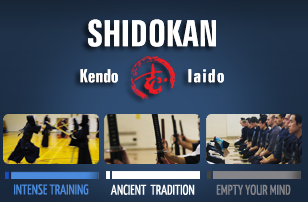Iaido, The art of drawing the sword 
Iaidō (居合道) is a Japanese martial art associated with the smooth, controlled movements of drawing the sword from its scabbard, striking or cutting an opponent, removing blood from the blade, and then replacing the sword in the scabbard. While new students of iaidō may start learning with a wooden sword (bokken) depending on the teaching style of a particular instructor, many of those who study iaidō use an unsharpened sword (iaitō). Advanced practitioners of iaidō use a sharpened metal sword (shinken).
Because iaidō teaches the use of actual metal weaponry, it is almost entirely based on the teaching of forms, or kata. Multiple person kata do exist within some forms of iaido, but the iaidōka (practitioners of iaidō) will usually use bokken for such kata practice.

Iaidō forms (kata) are performed individually against one or more imaginary opponents. Some traditional iaido schools, however, include kata performed in pairs. Some styles and schools also do not practice tameshigiri, cutting techniques.The primary emphasis in iaido is on the psychological state of being present (居). The secondary emphasis is on drawing the sword and responding to the sudden attack as quickly as possible (合).

Starting positions can be from combative postures or from everyday sitting or standing positions. The ability to react quickly from different starting positions was considered essential for a samurai (侍).
A very important part of iaido, is nukitsuke or the life of iai. This is a very quick draw accomplished by drawing the sword out of the saya by moving the saya back in saya biki. The blade may be brought out of the saya and used in a quick nukitsuke slashing motion.
Origin
The Tenshin Shōden Katori Shintō-ryū (天真正伝香取神道流) included iaijutsu in its curriculum in the 15th century. The first schools dedicated exclusively to sword drawing appeared some time during the late 16th or early 17th century. Hayashizaki Jinsuke Minamoto no Shigenobu (林崎甚助重信) (1546–1621) is generally credited with as being the originator of the first dedicated school of sword drawing. Little is known of his life, leading some scholars to doubt his historical existence as a real person.

The two largest schools of sword drawing that are practised today are the Musō Shinden-ryū (夢想神伝流) and Musō Jikiden Eishin-ryū (無雙直傳英信流). Both schools trace their lineage to Hayashizaki Jinsuke Shigenobu.

Before Nakayama Hakudo (1873?-1958) coined the word iaido early in the 20th century, various other names such as battō, battōjutsu, or saya no uchi were used. Iaido is the usual term to refer to the modern self-improvement oriented-form taught by the All Japan Kendo Federation (AJKF), while Iaijutsu is used for some amongst the older koryū combative techniques.
Muso Shinden Ryu Iai
Besides Seitei-Iai Instruction, Shidokan follows the Muso Shinden Ryu line of Danzaki Tomoaki Sensei through Fred Okimura Sensei passed on to his direct students Santoso Hanitijo (5th Dan), Robert Miller (5th Dan) and Dean Jolly (4th Dan).

Almost all Iai schools were derived from a common mythological founder, named Jushin (or Shigenobu, HAYASHIZAKI Jinsuke, etc). Muso Shinden is also one of the successors of Jushin style.

HAYASHIZAKI Shigenobu appeared circa 1560 - 1570, devised some forms of sword-drawing arts (i.e., Batto Jutu, an alternative Japanese name of Iai) for the first time.
We would regard Iai as a dance, a sport, or a spiritual training, but until recently it has been a real technique for assasination, or defence from opponents, characterized by the sudden and quick manipulation of the sword. We know that today's Iai styles have been modified a lot since it was first established.
Also the commercial movies, TV shows, comics, dramas, and street performance could be the source of our confusion and misunderstanding. You (Foreigners as well as Japanese) hear some times before that the Japanese martial arts are based on manners and etiquettes, starting with respect and ending also with respect. But at least in the days of the Civil Wars, rudeness was a more preferable virtue than such politeness.
Seitei Iaido
Seitei Iaido (制定) or Zen Nippon Kendo Renmei Iaido is the iaido style of the All Japan Kendo Federation (AJKF, Zen Nippon Kendo Renmei or ZNKR). The twelve Seitei iaido forms (seitei-gata) are now standardised for the tuition, promotion and propagation of iaido within the kendo federations.

Although not all dojo teach seitei iaido, the AJKF uses them as a standard for their exams and shiai. As a result, seitei iaido has become the most widely recognised form of iaido in Japan and the rest of the world.


